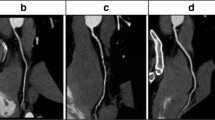Summary
To explore the feasibility and superiority of iodine delivery rate (IDR) and tube voltage determined by patients’ body mass index (BMI) in coronary CT angiography (CCTA), a total of 1567 patients undertaking CCTA during Feb. and Dec. 2016 were enrolled and divided into two groups. In the control group, the IDR and tube voltage were fixed, while in the experimental group, the IDR and tube voltage were determined by patients’ BMI. The volume of iodinated contrast media (ICM), extravasation rate, extravasation volume, extravasation recovery interval, incidence rate of adverse reactions, effective dose (ED) and image quality of the two groups were compared. The experiments demonstrated that the ICM volume, extravasation rate, extravasation volume, extravasation recovery interval, incidence of adverse reactions and ED were lower or shorter in the experimental group than in the control group, and the differences were statistically significant (all P<0.05). However, there were no significant differences in the mean CT value, image noise, signal to noise ratio and contrast to noise ratio between the two groups (all P<0.05), which were consistent with the diagnosticians’ subjective evaluation outcomes. Our findings suggested that in CCTA, it is feasible to determine the IDR and tube voltage based on patients’ BMI; low tube voltage and IDR are superior to the fixed tube voltage and IDR and are worthy of clinical promotion.
Similar content being viewed by others
References
Böhm I, Nairz1 K, Morelli JN, et al. Iodinated contrast media and the alleged “iodine allergy”: an inexact diagnosis leading to inferior radiologic management and adverse drug reactions. Rofo, 2017,189(4):326–332
Nash K, Hafeez A, Hou S, et al. Hospital-acquired renal insufficiency. Am J Kidney Dis, 2002,39(5):930–936
Yu M, Ma Y, Wang Yk, et al. Comparison of image quality among different low dose contrast materials injection protocols in coronary CT angiography. J Chin Clin Med Imaging, 2015,26(11):779–783
Sun Z, Fu Q, Cao L, et al. Intravenous N-acetylcysteine for prevention of contrast-induced nephropathy: a meta-analysis of randomized, controlled trials. PLoS One, 2013,8(1):e55124
Mao YJ, Ye WQ, Tian MM, et al. Study on nursing management of intravenous extravasation of iodine contrast medium. Chin Nurs Manag, 2010,10(4):63–65
Wang QS, Liang CH. Adverse reactions of iodinated contrast agents and the strategies for their treatment. Shanghai Med J, 2014,35(13):8–15
Iyer RS, Schopp JG, Swanson JO, et al. Safety essentials: acute reactions to iodinated contrast media. Can Assoc Radiol J, 2013,64(3):193–199
Liao WH. Progress in prevention and nursing of contrast medium extravasation in enhanced CT scanning. Quan Ke Hu Li (Chinese), 2016,14(17):1759–1762
Ghoshhajra BB, Engel LC, Károlyi M, et al. Cardiac computed tomography angiography with automatic tube potential selection: effects on radiation dose and image quality. J Thorac Imaging, 2013,28(1):40–48
Kok M, Mihl C, Seehofnerová A, et al. Automated tube voltage selection for radiation dose reduction in CT angiography using different contrast media concentrations and a constant iodine delivery rate. AJR Am J Roentgenol, 2015,205(6):1332–1338
Kok M, Mihl C, Hendriks BMF, et al. Optimizing contrast media application in coronary CT angiography at lower tube voltage: Evaluation in a circulation phantom and sixty patients. Eur J Radiol, 2016,85(6):1068–1074
Lell MM, Jost G, Korporaal JG, et al. Optimizing contrast media injection protocols in state-of-the art computed tomographic angiography. Invest Radiol, 2015,50(3):161–167
Lell MM, Fleischmann U, Pietsch H, et al. Relationship between low tube voltage (70 kV) and the iodine delivery rate (IDR) in CT angiography: An experimental in-vivo study. PLoS One, 2017,12(3):e0173592
Bae KT. Intravenous contrast medium administration and scan timing at CT: considerations and approaches. Radiology, 2010,256(1):32–61
Johnson PT, Pannu HK, Fishman EK. IV contrast infusion for coronary artery CT angiography: literature review and results of a nationwide survey. AJR Am J Roentgenol, 2009,192(5):W214–221
Bae KT, Tran HQ, Heiken JP. Uniform vascular contrast enhancement andreduced contrast medium volume achieved by using exponentially decelerated contrast material injection method. Radiology, 2004,231(3):732–736
Hausleiter J, Meyer T, Hadamitzky M, et al. Radiation dose estimates from cardiac multislice computed tomography in daily practice: impact of different scanning protocols oneffective dose estimates. Circulation, 2006,113(10):1305–1310
Feuchtner GM, Jodocy D, Klauser A, et al. Radiation dose reduction by using 100-kV tubevoltage in cardiac 64-slice computed tomography: a comparative study. Eur J Radiol, 2010,75(1):e51–e56
Kanematsu M, Goshima S, Miyoshi T, et al. Whole-body CT angiography with low tube voltage and low-concentration contrast material to reduce radiation dose and iodine load. AJR Am J Roentgenol, 2014,202(1):W106–116
Sistrom CL, Gay SB, Peffley L. Extravasation of iopamidol and iohexol during contrast-enhanced CT: report of 28 cases. Radiology, 1991(180):707–710
Hou QF, Gao L, Liu S. Identification and treatment of angio extravasation of contrast agents. China JMIT, 1999,15(9):732–733
Bottinor W, Polkampally P, Jovin I. Adverse reactions to iodinated contrast media. Int J Angiol, 2013,22(3):149–154
Keller M, Lerch M, Britschgi M, et al. Processing-dependent and -independent pathways for recognition of iodinated contrast media by specific human T cells. Clin Exp Allergy, 2010,40(2):257–268
Katayama H, Yamaguchi K, Kozuka T, et al. Adverse reactions to ionic and nonionic contrast media. A report from the Japanese committee on the safety of contrast media. Radiology, 1990,175(3):621–628
Yu L, Bruesewitz MR, Thomas KB, et al. Optimal tube potential for radiation dose reduction in pediatric CT: principles, clinical implementations, and pitfalls. Radiographics, 2011,31(3):835–848
Fan WP, Li SW, Ding J, et al. Individualized contrast medium injection protocols for coronary CT angiography. Chin Med Pharm, 2013,3(12):110–112
Author information
Authors and Affiliations
Corresponding author
Additional information
Conflict of Interest Statement
The authors declare no competing financial interests.
This project was supported by the New Century Excellent Talent Support Plan of the Ministry of Education, China (No. NCET-11-0438).
Rights and permissions
About this article
Cite this article
Yuan, W., Qu, Tt., Wang, Hj. et al. Coronary CT Angiography Using Low Iodine Delivery Rate and Tube Voltage Determined by Body Mass Index: Superiority in Clinical Practice. CURR MED SCI 39, 825–830 (2019). https://doi.org/10.1007/s11596-019-2112-5
Received:
Revised:
Published:
Issue Date:
DOI: https://doi.org/10.1007/s11596-019-2112-5




